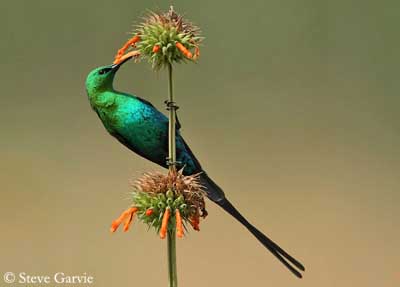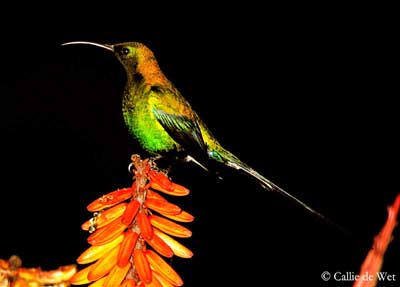
Fr: Souimanga malachite
All: Malachitnektarvogel
Esp: Suimanga Malaquita
Ital: Nettarinia malachite
Nd: Emeraldhoningzuiger
Sd: Malakitsolfågel
Photographers:
Steve Garvie
RAINBIRDER Photo galleries
Callie de Wet
Flickr Galleries
Text by Nicole Bouglouan
Sources:
HANDBOOK OF THE BIRDS OF THE WORLD Vol 13 by Josep del Hoyo-Andrew Elliot-Jordi Sargatal - Lynx Edicions – ISBN: 9788496553453
SUNBIRDS by Roberts A. Cheke, Clive F. Mann and Richard Allen Helm, 2001 - ISBN : 1873403801
BirdLife International (BirdLife International)
Wikipedia, the free encyclopaedia
XENO-CANTO – Sharing Birds sounds from around the world
Malachite Sunbird
Nectarinia famosa
Passeriforme Order – Nectariniidae Family
BIOMETRICS:
Length: M: 24-27 cm - F: 13-15 cm
Weight: M: 12-22, 5 g - F: 9-17, 5 g
DESCRIPTION:
The Malachite Sunbird is a long-tailed and long-billed African bird with iridescent bright green plumage.
The adult male in breeding plumage has bright metallic malachite-green plumage, except on rump and uppertail-coverts which are darker green. The upperwing shows sooty-black flight feathers with glossy blue edges. The lesser and median coverts are bright golden-green, whereas the tertials and the greater coverts are edged bright green.
The long tail (110-150mm) is dark, brownish-black with edged-dark green outer webs, except on the outermost rectrices. The central pair of tail feathers protrudes up to 8 centimetres beyond others. These feathers are edged green.
On the underparts, the pectoral tufts are bright yellow, but difficult to see at rest. The lower belly and the undertail-coverts are green washed blue.

The adult male in eclipse has metallic green wing-coverts, rump and uppertail-coverts. It lacks the long central pair of rectrices.

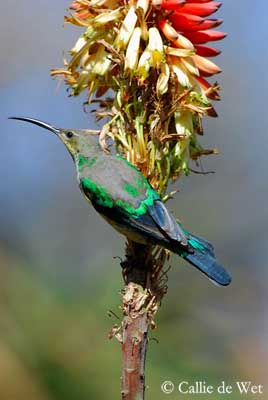
The long bill (30-36mm) is black and down-curved. The eyes are dark brown. Legs and feet are black.
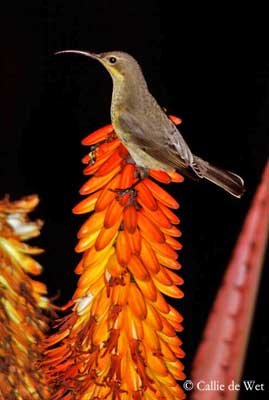
The female has brown upperparts washed grey-olive. The tail is olive-black with white-tipped and edged outer rectrices. Other tail feathers have white-edged outer webs.
The upperwing shows yellow-olive edges on the outer webs. She lacks the pectoral tufts and the elongated tail feathers.
On the underparts, throat and breast are pale yellow with brown spots and yellowish wash. The belly is less marked and can be bright yellow or green-yellow. The flanks are olive. The undertail feathers are greyish-white.
The head is brownish with pale yellow malar stripe and narrow white eyebrow.
The juvenile resembles female but it has greener upperparts and yellower underparts.
We can find two subspecies:
N.f. famosa occurs in E Zimbabwe and Mozambique, and S Namibia, South Africa, Lesotho and W Swaziland.
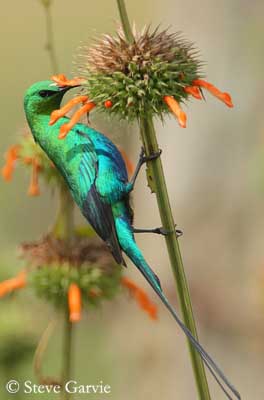
N.f. cupreonitens is found in Eritrea, Ethiopia, S Sudan, E DRCongo, Uganda, Kenya, Tanzania, NE Zambia, N Malawi and N Mozambique.
This one has shorter bill (26-31mm) with more golden-green above and darker blue below. The central rectrices are shorter than nominate (94-120mm).
VOICE: SOUNDS BY XENO-CANTO
The Malachite Sunbird utters liquid “tseuu, tseuu” or “tsi-tseer” as contact calls. The alarm call is a trill “trreeeee” repeated, or a slower “tjoep, tjoep, tjoep”.
The song is a series of whistles with alternated high and low notes “tseuu, tseuu, pesui, pesui, pesui” or “tik-tik-tik-tik-tik-tik-heezy, heezy, heezy, heezy”.
When in eclipse plumage, the male usually sings differently and utters a rapid warble interspersed with “chip” calls.
HABITAT:
The Malachite Sunbird likes open habitats, scrubby moorland and forest edges. It also frequents alpine meadows, scrub and gardens.
This species can occur at high elevation, 2400 metres in Ethiopia, 3000 metres in Tanzania, and from sea-level up to 2800 metres in South Africa.
RANGE:
See above “subspecies”.
BEHAVIOUR:
The Malachite Sunbird feeds primarily on nectar and insects. It takes the food from several plant species such as Lobelia and Aloe, and also Kniphofia (Liliaceae). But numerous other plants are visited. It also hawks insects from exposed perch.
It feeds and forages alone or in pairs, or in loose groups of 30-40 birds. They are highly aggressive between them, as well other sunbirds as larger birds from starling to Egyptian Goose.
They grip the intruder on the back from behind, and it can be forced to ground.
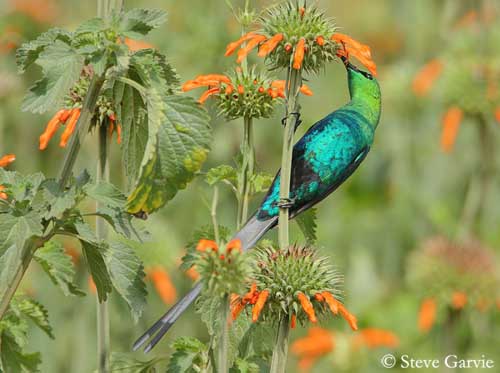
During the fights between males, they grapple with the feet in mid-air, grasp their breasts and tumble to the ground. These fights are accompanied by screeching calls.
During the breeding season, they perform aerial displays, high flight followed by vertical dive towards the female, a zigzagging flight with held out wings at body level and with raised tail and head, and a moth-like flapping flight.
The song is given with head held upwards and half-spread dropped wings, with vibrating body. The yellow pectoral tufts are displayed.

Another hypothesis talks about “Nocturnal Pectoral Tuft Display”. These bright patches are also displayed during the night while the bird is asleep. That could suggest that these bright feathers, similar to “eyes” in the darkness, could be able to keep off the predators.
This bird is able to manage the cold temperatures at high altitudes.
The Malachite Sunbird is nomadic when searching for flowers. Some altitudinal movements are observed in Kenya, coming down to 1400 metres. On the other hand, it also moves to higher elevations during the droughts in Zimbabwe, to feed on Aloe.

FLIGHT:
The Malachite Sunbird can fly long distances and it reaches speeds of more than 50km/hour. It performs agile and beautiful flight displays.
REPRODUCTION:
The breeding season varies according to the range.
After the courtship displays, the male flies vertically before hovering above the female and descending to copulate, while she utters “pseeep-pseeep” calls.
The female builds the nest, but the male follows her when she forays for materials. The nest is oval, often with porch and sometimes with “beards”. It is made with grass, plant fibres, leaves, twigs, rootlets and spider webs. Lichen and white cocoons are added as ornaments outside. The interior is lined with soft grass, hair, feathers, down and wool.
The nest is placed within a bush with an entrance facing inwards, between near ground and 20 metres up in tree or bush, often above the water.
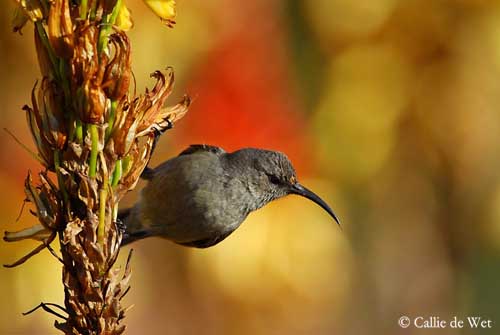
The female lays 1-3 eggs and incubates during about 13 days. She also feeds the chicks, sometimes helped by the male. The young fledge at 2-3 weeks of age. They are still fed by both parents, and return to the nest at night during two weeks more.
The nest can be parasitized by cuckoos.
This species produces 2-3 broods per year and the same nest can be reused.
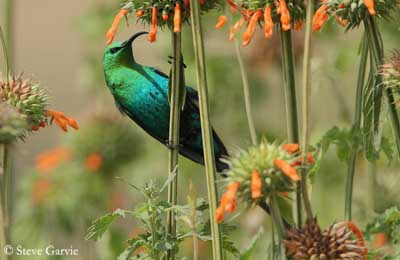
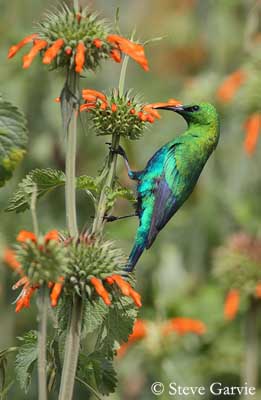
DIET:
The Malachite Sunbird feeds on nectar from several plant species, and also hawks insects from a perch.
PROTECTION / THREATS / STATUS:
The Malachite Sunbird is common to locally common according to the range. This bird is uncommon in Ethiopia and Sudan.
This species is not currently threatened.
